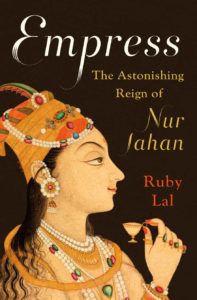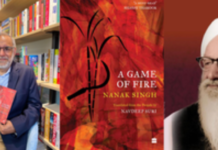Title: “Empress: The Astonishing reign of Nur Jahan,” Author: Ruby Lal; Publisher: W.W. Norton; Pages: 308; Price:$27.95

Nur Jahan, meaning “Light of World,” named by her husband, the Mughal Emperor Jahangir, was born only a few decades after Queen Elizabeth I of England, yet she ruled a territory vastly more diverse than her British counterpart. Today Nur Jahan is comparable to Cinderella in the West, girls grow up reading stories of how she and Jahangir met and fell in love. Many have heard the romanticized stories, however they know next to nothing about her dynamic world, political acumen, and powerful ambition. She didn’t come from royalty like Queen Elizabeth, Cleopatra, or other renowned women rulers, and yet she ascended from the emperor’s harem to great heights as an astute politician and favorite wife of Jahangir. Ruby Lal’s EMPRESS: The Astonishing Reign of Nur Jahan is an eloquent biography that tells the story of India’s first female leader, a fascinating woman who came to rule an empire.
To discover what circumstances produce a ruler like Nur Jahan, Lal suggests we look to the incredibly rich, tolerant culture of India that allowed for different sensibilities, religions, and traditions to coexist, and the special relationship she and Jahangir enjoyed. Nur Jahan, born Mihr un-Nisa in 1577 on the road outside Kandahar as a comet streaked across the sky, was the daughter of Persian nobles who left their home, in what is now Iran, amidst increasing intolerance under the Safavid dynasty, to seek refuge in the more liberal Mughal world. Raised in a blend of traditions from her parents’ birthplace and their adopted homeland.
Nur was given refuge in Jahangir’s harem, after the passing of her first husband, where her fellow harem women  grew to trust and admire her, and in 1611, she wed Jahangir, becoming his twentieth and final wife. Lal writes that Jahangir painted “an admiring portrait of Nur Jahan as a sensitive companion, superb caregiver, accomplished adviser, hunter, diplomat, and aesthete.” Many histories dismissed Jahangir as an ailing drunkard who no longer had the stamina or focus to rule his kingdom and so, besotted with his newest bride, gave up control to her. EMPRESS tells a different story. “Yes,” Lal writes, “the emperor was a drinker and he smoked opium. Yes, he was deeply in love with this wife. But that’s not why [Nur] became a ruler to be reckoned with.” In fact, Nur and Jahangir complemented each other, and Jahangir never considered Nur Jahan’s growing power as abdication.
grew to trust and admire her, and in 1611, she wed Jahangir, becoming his twentieth and final wife. Lal writes that Jahangir painted “an admiring portrait of Nur Jahan as a sensitive companion, superb caregiver, accomplished adviser, hunter, diplomat, and aesthete.” Many histories dismissed Jahangir as an ailing drunkard who no longer had the stamina or focus to rule his kingdom and so, besotted with his newest bride, gave up control to her. EMPRESS tells a different story. “Yes,” Lal writes, “the emperor was a drinker and he smoked opium. Yes, he was deeply in love with this wife. But that’s not why [Nur] became a ruler to be reckoned with.” In fact, Nur and Jahangir complemented each other, and Jahangir never considered Nur Jahan’s growing power as abdication.
Soon after their marriage, as her influence grew both within the harem and the court, she issued her first royal order. She was the first Mughal woman to do this and it signified her movement toward co-sovereignty. In 1617, gold and silver coins that bore her name, opposite Jahangir’s, began circulating. During this time Nur Jahan also distinguished herself as an expert markswoman and architect. Lal chronicles how in act after act—hunting, issuing imperial orders and coins, designing public buildings—Nur Jahan ensured that her name was etched indelibly in public memory and in history.
EMPRESS is an absorbing, rich, and evocative account of India’s first woman ruler. Lal shows that Nur Jahan’s story is much more complicated—and remarkable—than ever before known. At a time when Western misunderstanding of the Muslim world and its history seems to be deepening, readers will marvel at the Muslim woman who designed intricate buildings and gardens, championed the disadvantaged, hunted tigers, and even went to war to rescue her husband. Beautifully written and deeply researched, EMPRESS brings Nur Jahan’s biography to light and awakens us to an important chapter in the Mughal Empire’s fascinating history.














